Monday 20th October 2014
You would think that after travelling this region for as long as we have we would understand and remember that visitor attractions close around 12.30 or 1.00 and stay closed till around 4.30. We arrived at places during this period so many times last winter that you would have thought it engraved on our brains. Not so, we have done twice in the past seven days, the first I kept quiet about, the second was today. We set off for a trip to the cathedral at Palencia, which the guide book said is known as La Bella Desconocida (the Unknown Beauty). It’s a 100 km so quite a way but we intended to visit Frómista on the way back.
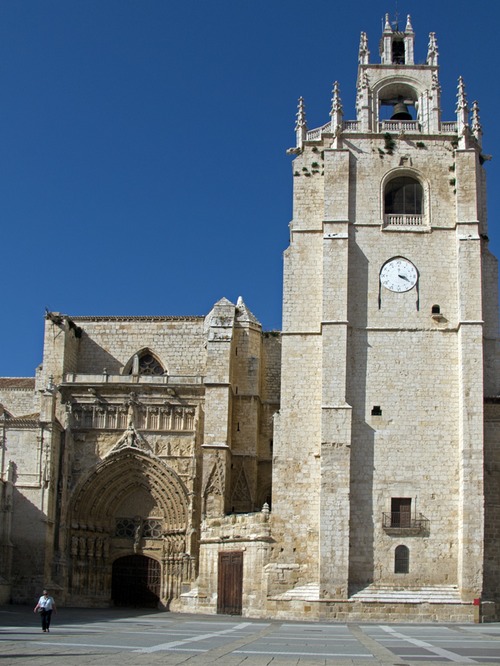
The cathedral at Palencia is the city’s main (only?) tourist site and we should have realised things were not quite right when we easily found a parking place in the city centre and bought a parking ticket, but no, we wandered off following the signs to the cathedral and after about twenty minutes walk came upon the imposing building. Finding the main entrance closed we scouted around till we found a notice that said it was closed between 12.30 and 4.30. It was then 3.00 so another hour and a half that had we waited and then spent an hour or so inside, would have made us pretty late by the time we got to Frómista, and very late by the time we got back to the van. Oh well saved for another day.
I have been coming to Spain since 1995 and soon learned that the origin of the Tapas is thought to be a slice of bread or meat which sherry drinkers in Andalusian taverns used to cover their glasses between sips. This was a practical measure meant to prevent fruit flies from hovering over the sweet sherry. The meat used to cover the sherry was normally ham or chorizo, which are both very salty and activate thirst. Because of this, bartenders and restaurant owners began creating a variety of snacks to serve with sherry, thus increasing their alcohol sales. In my experience Tapas are sold (not given free) and to have a Tapas meal is always expensive so imagine our surprise when we stopped in a cafe for a cup of coffee (well to use the loos really) and were presented with two little slices of bread each with savoury goodies on top - yummy.
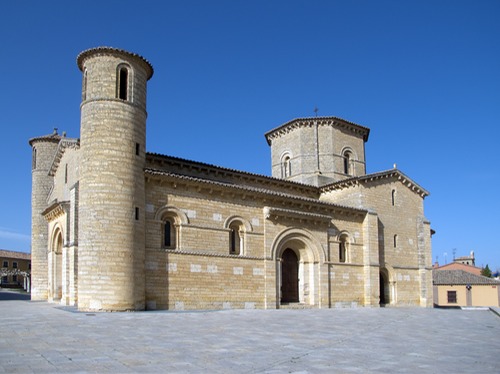
Frómista, a small town on the road to Santiago de Compostela is the site of one of Spain’s purest Romanesque churches the Iglesia de San Martin. It is the highlight of the town partly due to a restoration in 1904 that left the church, dating from 1066 entirely Romanesque in style. The presence of both Pagan and Roman motifs suggest it may have pre-christian origins.
We got back too late for a cooked meal and had to make do with cheese and biscuits washed down with a bottle of ruby port - ain’t life a bitch 😊.
Tuesday 21st October 2014.

We went to see the source of the multi-bong bell today - The Carthusian Monastery Of Our Lady Of Miraflores, home to twenty five monks, fifteen “fathers” and ten “brothers” who live in the monastery constructed on the site of a 15th century hunting lodge of the same name. The church building is very ornate and well worth a visit.
After siesta, which we learned from Trip Advisor lasts from 14.00 till 15.00 we decided to visit Burgos Castle which is high on the hills to the north west of the city centre. Arriving at 4.30 we were surprised to find it still closed until reading the sign outside when we discovered it is only open Saturdays, Sundays and Fiesta days at this time of year - oh well even without going into the castle there are superb views over the city.
Wednesday 22nd October 2014.
Today we had planned to visit the second UNESCO World Heritage Site in Burgos - The Archaeological Site of Atapuerca.
“ . . . The Atapuerca Sierra was declared Heritage of Humanity due to the large number of paleo-archaeological remains hidden in the bowels of the earth. Groups of Homo intercessor, Heidelbergensis, Neanderthal man and Homo sapiens walked, slept, harvested and hunted in the beautiful areas of which it is composed. Today it is one of the main sources of remains of human activity in previous periods of the world, on which important investigation activities are being carried out that is allowing a more in-depth knowledge of the evolution of the human species through discoveries associated with it . . . “ (source - Junta de Castilla y León)
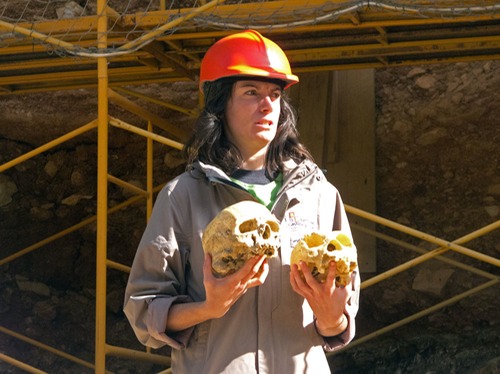
It is not a turn up and look site but a book in advance tour/lecture (unfortunately in Spanish only) and when we arrived at the visitor centre and asked for two tickets there was a sucking of teeth and the question “¿why have you not already booked? We only have one seat on the bus left” the lady allocated that one seat to us and said if one of the other 51 people fail to show or canceled we would have first option on the only bus today that left for the dig site in an hour and a half. One person obviously did cancel as an hour and forty minutes later we were on the bus as it made its way slowly to the dig site. Marie the young woman guide, very knowledgable and well qualified in an “ology” of some description was kind enough to give us a mini lecture in English at the end of each Spanish one. She was very enthusiastic and described the digs and the people who lived there using lots of visual aids and hand signals so even without the English extras it would still have been an interesting and worthwhile visit, but you don’t have to rush as the archeologists dig only in July and then only 10cm as the site if so rich in finds that gives them sufficient for eleven months study and research into those finds and with the site being so big our guide said that not only would the research take longer than her lifetime she expected it would take longer than many lifetimes.
Thursday 23rd October 2014.
Moving Day!! Not a long move from Burgos to a small town called El Escorial with a large campsite called El Escorial Camping Resort. So big is the campsite that when full it’s population must be several times that of the town with 693 pitches and 699 static/bungalow pitches on 30 hectares. I think it’s the biggest site we have ever been on. The pitches are on the small side with the access roads also on the narrow side but at this time of year none of that matters as we seem to be the only campers on site. Because of the narrow access roads and the number of trees bordering them our new motor mover was used for the very first time, after I spent ten minutes trying to remember how to get the auto engage to engage it worked like a dream. I cannot say how much better than the old one it is, and when I have learned any foibles it might have it will be even better. Having got the van onto a Spanish 90 square metre pitch (Spanish 90 square metre pitches are smaller than other nationality 90 square metre pitches) with such precision that the sunshade could be erected and still be able fit the car on what was left l felt pretty pleased with Powerful Pete the mover.
Friday 24th October 2014.
There was another Unicorn S2 on site last night, I had a brief chat with its owner this morning, they got off the ferry yesterday and drove 400 km to here and today they will drive over 500 km to Camping Los Madriles where they will pitch and stay till March. Better than staying in cold and wet UK obviously😎 but it seems sad to miss such superb countryside and all the other attractions when you have nearly five months available.
Because we were getting up later and later we have set an alarm that will sound (bird song and the sound of a gentle fountain) every morning at 8.15 am and having got up nice and early and had breakfast at a reasonable time we toddled off to the palace at El Escorial San Lorenzo only to find there was nowhere for us to park, there is a car park but that is underground and even if we took our top box off the car would still be 5 cm (2”) to high to get in. After driving around the narrow streets for a while, we returned to the van to contemplate the problem. Having had our tea and contemplation we decided to go to another local historical monument and having programmed it into the sat-nav set off, however the sat-nav obviously decided it needed to go back to El Escorial San Lorenzo because despite the new destination programmed in thats where it took us. This time we managed to find a parking spot about twenty minutes walk from the palace (fifteen minutes hard slog up hill then a five minute trot down an equally steep other side). The palace had far stricter security than the average Spanish airport as not only did we have to empty all pockets etc and shove everything through an x-ray machine before buying tickets, my passport was required before they would allow an OAP concession and once inside all bags, phones, cameras etc had to be locked away before starting the tour so, no photos.
The tour itself was a little uninspired, others have said it was austere although it was certainly long as you follow signs through the various buildings. We went quite quickly (but still far, far slower than the Spanish) and still took over 2.1/2 hours to get round.
“ . . . The palace was originally conceived as a mausoleum and contemplative retreat rather than as a splendid residence. Its artistic wealth, which includes some of the most important works of art of the royal Hapsburg collection, is concentrated in the museums, chapterhouses, church, royal pantheon and library. In contrast the royal apartments are remarkably humble . . .” (source - DK Eyewitness Travel - Spain)
The site has started filling with Spanish weekenders so we expect it to start buzzing soon as the parties get under way.
Saturday 25th October 2014.
Up early this morning, the alarm hasn’t been turned off yet nor has the phone been thrown at the wall but I expect it’s only a matter of time, and popped to the shop for croissants for breakfast. The sun is shinning from a deep blue sky and the temperature in the 30’s. We are off to an attraction that some Spanish avoid, it is Santa Cruz del Valle de los Caidos - The Holy Cross of the Valley of the Fallen. General Franco had it built as a memorial to those who died in the civil war. The immense cross dominated the surrounding countryside. The cross is 150m (490 ft) high and rises above a basilica carved 250m (820ft) into the rock by political prisoners a number of who died during the project which took over twenty years to complete. To one side of the basilica’s high alter is the plain white tombstone of Franco and on the other side that of José Antonio Primo de Riviera, the founder of the Falange Española Party. Some 40,000 coffins of soldiers from both sides in the civil war (1936-1939) lie here out of sight of public view.
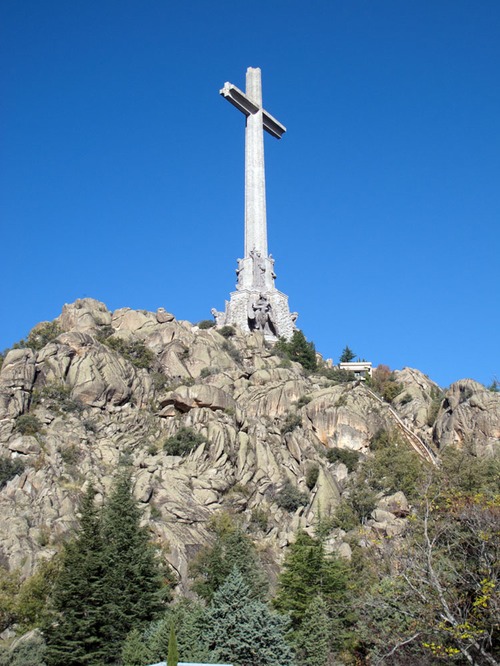
This is a sombre place that many Spanish feel a chilling symbol of the dictatorship. It was chilling that the tombs of both Franco and de Ribiera had fresh wreaths of flowers laid by the basilica authorities and fresh flowers brought and laid by visitors. Groups offering the fascist salute are sometimes to be seen and controversy rages over whether to move Franco (who was said to have wanted to be buried in Madrid) so the site may become a place of reconciliation.
Sunday 26th October 2014.
The end of summer time, an extra hour in bed - Hurrah!!
After enjoying our extra hour we toddled off to Segovia and, rather than the quick route down the motorway, we followed the M601 over the mountains. What a fabulous drive, we reached a height of just under 2000m (6500 ft) with superb views and on reaching Segovia discovered an absolutely stunning town. It took a bit to find a parking space (without a top box it would have been easy) but when we did, being Sunday it was free and not that far from the main sights of the viaduct, the cathedral and the palace. We stopped in the palace coffee shop and were staggered that a tea and a coffee with milk were just €3.00 (£2.36) compare that with Costa! and we got a tapa for free - a portion of sepia (cuttle fish) cooked in a herby tempura batter - delicious.
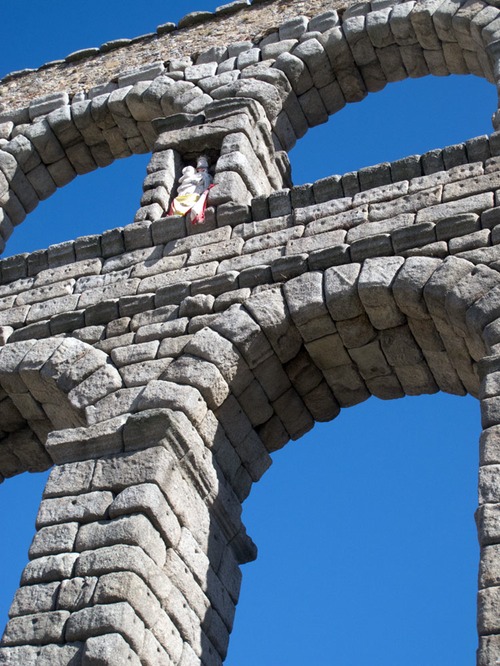
The viaduct was built some 2000 years ago (by the Romans) with stones dressed and placed to together without mortar which provided water to the town and palace until the mid 19th century. Today being Sunday we saw the cathedral from the outside only, it is a tall imposing building that if the inside is as impressive as outside will be well worth a visit.
The jewel in the Segovia’s crown is the castle (Alcazar) and is one of the inspirations for Walt Disney’s Cinderella Castle.
A serious fire on 6th March 1862 destroyed many of the rooms and ornate ceilings but good records enabled exact replicas of many parts of the castle to be made so that it is now impossible for a lay person to know it is not the genuine article.
The old town of Segovia and its aqueduct is a UNESCO World Heritage Site.